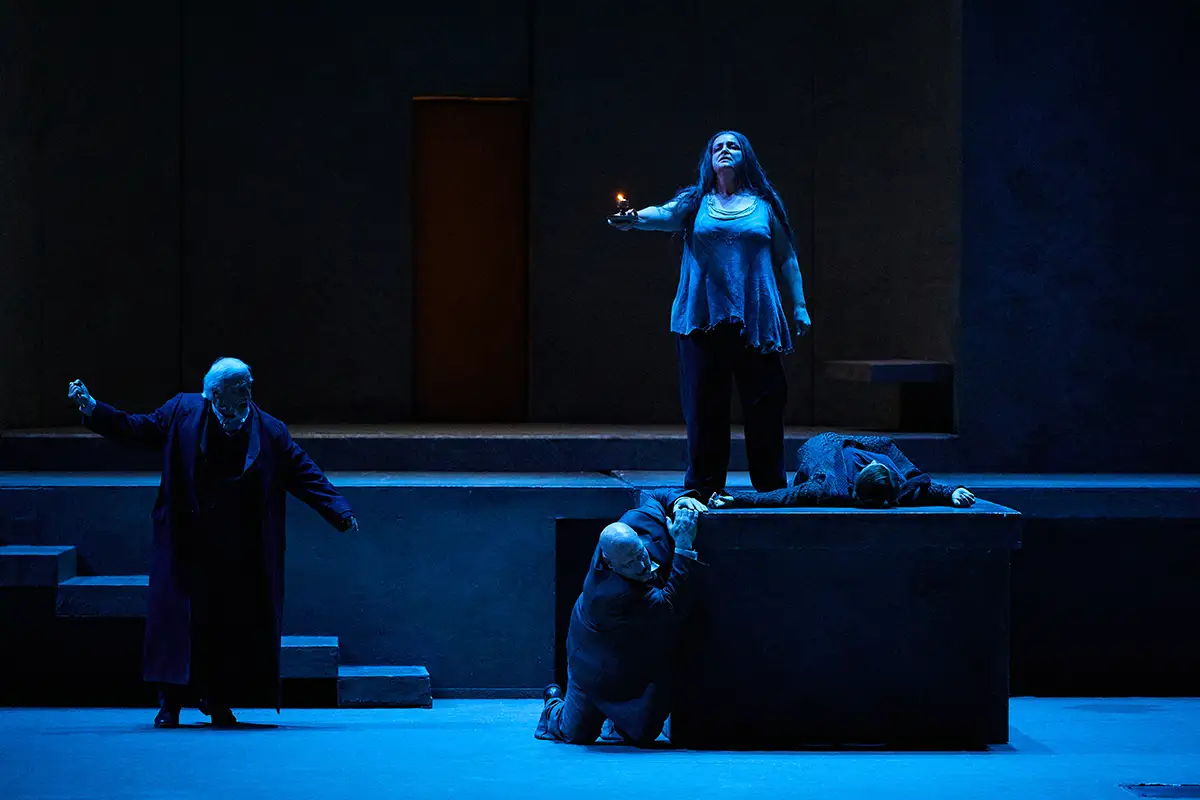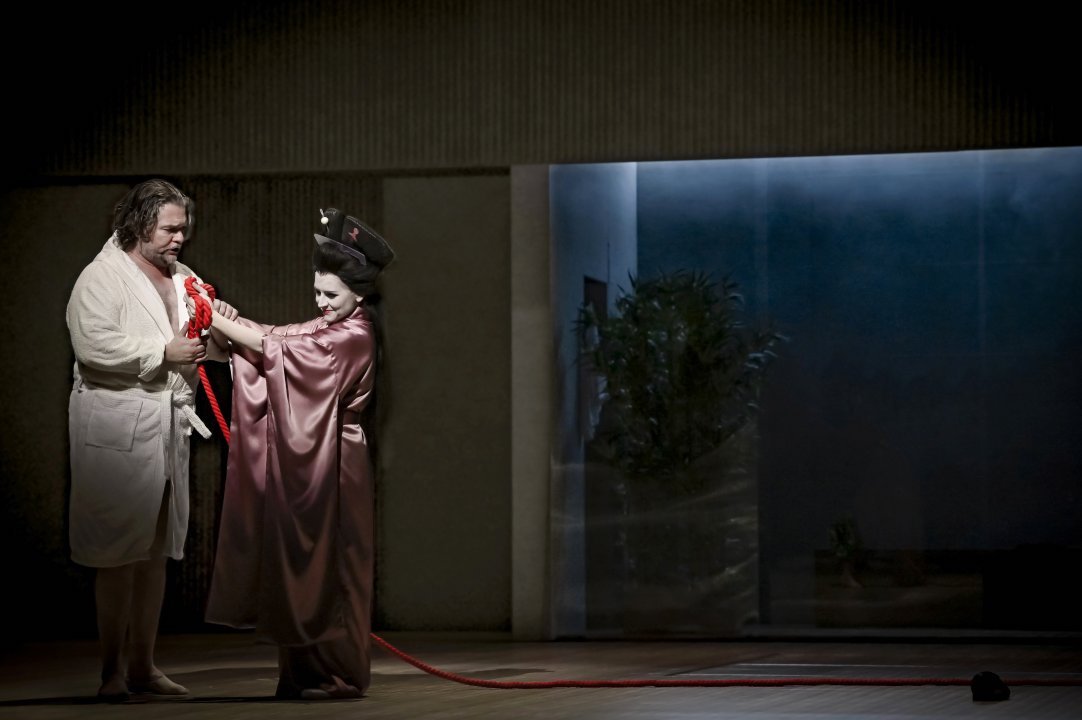Richard Strauss’ Elektra is a brutal opera. The title role requires a dramatic soprano to maintain total control across her entire range, from low A to high C. While navigating the rapidly descending and ascending vocal lines, she must also preserve the clarity of the words. The voice is often projected over a very large orchestra and there is chromaticism as well as dissonance, verging on atonality to be negotiated. On top of this there is the physical exertion of being on stage, in the limelight, for nearly uninterrupted 100 minutes.
The opera’s bursts of polytonality – with major and minor chords nearly clashing – can still startle an experienced opera-goer. When the orchestra cranks the volume up to eleven – or even twelve – you just have to ride with it. There is no respite: this one-act opera is always played without an interval. But in this masterpiece, there is no gain without (a little bit of ) pain.
The Finnish National Opera’s production of Elektra makes me want to relive the pain – I’ve never heard better singing and playing at this opera house. Ricarda Merbeth’s portrayal of the obsessive, mad, revengeful, psychopathic and axe-wielding Elektra is the stuff of nightmares. Condemned by her mother, Klytaemnestra (Sophie Koch), to live like a dog in the yard, Elektra’s (Merbeth’s) animalistic howling and wailing sends chills down your spine – and yet it’s thrilling. She convincingly portrays a woman who is determined, independent and fearless. A modern woman, but highly strung to the extreme.
In the original Electra plays by Aeschylus, Euripides and Sophocles the rebellious character defies the expectations of Ancient Greek society, where women were expected to be submissive. In Greek mythology women were often blamed for the societal ills and the downfall of men.
It’s rare these days to see a production of Strauss’ Elektra set in ancient times. Patrice Chereau’s production for the Finnish National Opera places the action in a courtyard of a castle that resembles a bunker or a prison yard. In this society, it’s understood that Klytaemnestra’s daughters are essentially her captives – at least until they marry. The costumes are modern and smart-casual, though Elektra appears unkempt and bedraggled, dressed in ragged blouse.
Chereau originally directed Elektra for the Aix-en-Provence festival and it was his final opera production before his death in 2013. Revival director Peter McClintock has ensured that the legendary Frenchman’s staging remains as relevant as ever.
Elektra has some of Brünnhilde’s heroic characteristics and the hallmarks of Hamlet – she loathes her mother, Klytaemnestra (Sophie Koch), yet clings to her emotionally, embraces her, and wants to sink “her roots into her”. She physically intimidates her spineless sister Chrysothemis (VidaMiknevičiūtė ) urging her to join in murdering their mother. But Chrysothemis longs for a married, normal and trouble-free life. She begs her sister to let go of the past, only to be met with the defiant reply “I cannot, I’m no beast’. Miknevičiūtė is perfectly cast as the slim, youthful looking and fragile Chrysothemis. But appearances deceive – her intense light dramatic soprano slices easily through the dense orchestral ’noise’.Merbeth’s Elektra, by contrast, is a plus-sized, disheveled figure – one you definitely wouldn’t want to cross.

Klytaemnestra (Sophie Koch), enters dressed in virginal whites – visually she’s more striking than her daughter. Plagued by terrible nightmares, she unexpectedly seeks advice from her estranged daughter, Elektra, who, though unhinged, is reputed for her wisdom in these matters. Elektra reveals the rite that’s necessary to stop the nightmares: her mother has to make a blood sacrifice —but it must be Klytaemnestra herself who dies, and she predicts that her exiled son Orestes will return and perform the fatal dagger blow. Horrified by Elektra’s bloodthirstiness Klytaemnestra prepares to leave, but a lady-in-waiting interrupts and whispers in her ear that two strangers have arrived with the news that Orestes is dead. Klytaemnestra returns to the palace elated, Elektra’s prediction can no longer come true, she thinks.
French mezzo-soprano Sophie Koch, once celebrated for trouser roles like Octavian (Der Rosenkavalier) and the Composer (Ariadne auf Naxos), brings maturity and swagger to the role of the murderous queen. But was Klytaemnestra justified in killing Agamemnon, who had sacrificed their daughter Iphigénie to Artemis? Strauss and von Hofmannsthal ignore the backstory and simply side with Elektra’s point of view.
Elektra realies she will have to kill her mother herself. She tries to persuade Chrysothemis to join her, but her sister flees. The strangers have been quietly watching the scene, but now Orestes—still in disguise—steps forward. Elektra does not recognise him at first, but when the older servants throw themselves at his feet, she realises who he is.
Sam Taskinen (Orestes) is a bass-baritone, as required for the role, but her voice is lightweight, which made the lower register sound uncomfortable and strained. While casting a trans performer in the role may aim to present Orestes as a more humane killer, rather than a vengeful son, in this case, Taskinen’s voice did not align well with the arduous demands of the score. The scene between Orestes and Elektra also felt rather flat.’
Orestes’is summoned by his guardian to perform the rite. They enter the palace. Elektra agonises that she’s forgotten to give him the axe with which her father was slaughtered. Then screams are heard. Servants flee. Klytaemnestra has been slaughtered.

Aegisth, Klytaemnestra’s paramour, arrives unaware of the murders going on, and he is led into the palace by Elektra. His screams are to no avail. Orestes stumbles through the courtyard (wounded or shocked), out through the gate while in the palace the fighting continues.
Elektra finally performs a triumphant and exulted dance. Well, Merbeth doesn’t exactly dance but instead does an uncoordinated, stumbling , kind of twirl and swirl routine, before collapsing on the floor, her mission accomplished. A life lost, totally devoted to revenge.
The set is spartan and remains unchanged throughout, but Dominique Bruguière’s lighting design is subtle and effective. The focus is firmly on the soloists—and, of course, the music.
Hannu Lintu led the orchestra with verve and the flexibility required for a score filled with tricky tempo markings, contrapuntal textures, and abrupt key changes. Lintu made sure that the brilliant Orchestra of the Finnish National Opera brought out the romantic lyricism of the score.The iconic opening—with its central musical motif, the Agamemnon theme—and the subsequent harmonies, all seemingly derived from that “single germinal chord whose flavour pervades the score,” set the tone for one of the most dramatic and blood-curdling opera evenings I have ever experienced in Finland.
Dance’SEEN AT FINNISH NATIONAL OPERA 1 OCTOBER 2025

